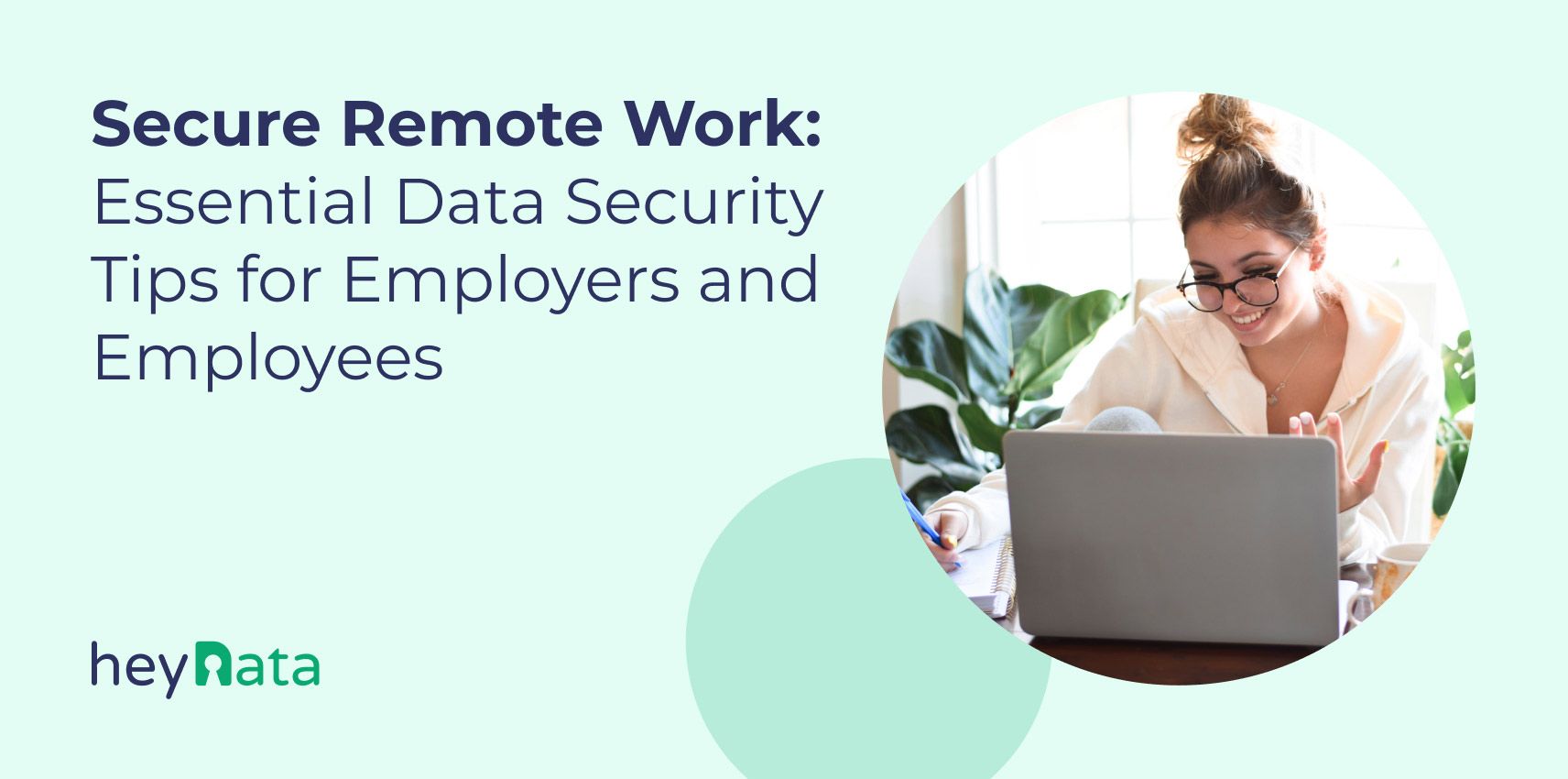
Secure Remote Work: Essential Data Security Tips for Employers and Employees

Explore the evolving landscape of remote work post-COVID-19 and the security challenges it presents. Learn essential cybersecurity tips for employers and employees, including compliance training, vendor monitoring, email security, software updates, access control, and more. Discover how to create a secure remote work environment to safeguard sensitive data and maintain productivity.
Table of Contents:
Secure Remote Work: Essential Data Security Tips for Employers and Employees
The transformation of the modern workplace is no secret. In the wake of the COVID-19 pandemic, remote work has become a standard practice for many organizations as a study released by Zug, Switzerland-based serviced office provider IWG revealed that 70% of global employees embrace remote work at least once per week.
However, while the flexibility of working from home is undoubtedly appealing, it brings along its own set of security challenges. Among remote employees, you'll come across a diverse group that includes both third-party service providers and in-house employees, all of whom may operate from remote locations, frequently utilizing public Wi-Fi networks.
Furthermore, these shared workspaces, once primarily favored by freelancers and startups, have now extended into the corporate sphere. They offer businesses and employees an affordable alternative that delivers increased flexibility and freedom in terms of where and how work is conducted. However, beyond concerns like man-in-the-middle attacks or employees using outdated operating systems on personal devices, there are more visible threats. Unauthorized access to or viewing of someone else's screen and the increased susceptibility of laptops being stolen in public spaces also pose significant security threats.
In 2023, several notable companies experienced data breaches due to stolen passwords:
- T-Mobile announced that they were victims of a second data breach in February 2023, where hackers gained access to the personal information of hundreds of customers.
- Mailchimp also experienced a security breach after attackers gained access to employee credentials through a social engineering attack on Mailchimp employees and contractors, allowing them to view the data of 133 customers.
- Google Fi confirmed that their customers' personal information was compromised in a recent cyberattack suspected to be related to a data breach at T-Mobile in February 2023.
Learn more about businesses that have experienced data breaches and get expert tips for creating strong passwords here.
Whether you find yourself in the position of an employer overseeing a remote workforce or an employee working from the comforts of your home or a remote place, cybersecurity should be a top priority. In this blog post, we'll provide you with essential security tips to ensure a secure remote work environment for both employers and employees.
Related topic: Defending Against Data Breaches: The Power of Third-Party Tool Assessment
25 Security Tips for Employers and Employees Handling a Remote Workforce:
Cybercriminals are continuously evolving and becoming more sophisticated in their network attacks. Therefore, it's crucial to provide regular compliance awareness training to all employees, including third-party service providers, to ensure they are well-prepared to respond to cybersecurity emergencies. A single misstep, such as clicking on a malicious link, opening a suspicious email, or downloading a harmful file, can pose significant risks to your operations. However, these potential disasters can be averted with robust and proactive cybersecurity measures, including:
1.Invest in compliance awareness training
Provide ongoing cybersecurity training to educate all members about recognizing and avoiding various cyber threats.
2. Monitor third-party vendors and service providers
Extend risk management practices to third-party service providers and vendors, as their employees working remotely can also pose security risks.
heyData's Vendor Risk Management streamlines the time-consuming process of legal research by providing essential insights, including data transfer information, data processing risks,data processing contracts, and security details.
3. Implement Email security practices
Enhance email security with measures like SPF, DKIM, and DMARC policies to prevent email spoofing and phishing attacks.
4. Up-to-date software
Activate automatic updates for the operating system and security software, especially on company-issued devices using public networks.
5. Printing and photocopying guidelines
Encourage employees to avoid printing or photocopying sensitive data on shared equipment in the office and coworking spaces. If necessary, provide guidelines for safeguarding and proper disposal of physical documents.
6. Use access control
Implement access control policies to reduce the risk of data breaches and privileged escalation attacks.
7. Enable Firewall Protection
Ensure that the firewall is activated on all company devices, providing an additional layer of defense against unauthorized access and external threats. This step fortifies your network security and shields devices from potential breaches.
8. Invest in data hygiene
Promote good cyber security practices and make data hygiene a part of your organizational culture. For instance, obscure personal data when creating reports to minimize exposure and potential risks. Additionally, ensure the deletion of confidential details when they are no longer necessary, reducing the chances of unauthorized access or data misuse.
9. Shredding policy
Mandate secure destruction of all confidential data, including paper documents, hard drives, and other media, with the help of a professional service provider.
10. Ensure web applications use HSTS
Enable HTTP Strict Transport Security (HSTS) to protect your websites and users from certain web-based attacks.
11. Use security metrics
Monitor team members’ adherence to information security policies while working remotely using security metrics.
12. Enforce strong passwords on employee devices
Require strong passwords on company devices to enhance security.
13. Invest in organization-wide password management tools
Make it easy for employees to create and manage strong passwords using password management tools.
14. Encrypt all company devices
Ensure that all company devices are encrypted to protect sensitive data.
Related topic: Passkeys and Data Privacy: A Secure Path to a Passwordless Future
15. Secure Your Home Office
Maintain physical security by treating your home office as you would your workplace. Lock your home office when you step away, and don't leave laptops unattended in vulnerable areas.
16. Separate Work and Personal Devices
Strive to keep work and personal devices separate to minimize the exposure of sensitive data if one of them is compromised.
17. Encrypt Your Devices
Enable encryption on your devices to protect data from unauthorized access in case of loss or theft.
18. Use Supported Operating Systems
Always use supported and up-to-date operating systems to receive security patches and protect your device from vulnerabilities.
19. Enable Automatic Locking
Configure automatic locking for your devices to protect them when unattended, with reasonable time intervals.
20. Keep Your Operating System and Software Up-To-Date
Apply security patches and updates as soon as they are available, as delays can pose significant risks.
21. Use a Strong PIN/Password
Employ strong and unique PINs or passwords to prevent unauthorized access, avoiding easily guessable combinations.
22. Use Antivirus Software
Install antivirus software to protect your computer from various types of malware.
23. Invest in a Password Manager
Consider using a password manager to generate and securely store strong, unique passwords for different accounts.
24. Enable Two-Factor Authentication (2FA)
Implement 2FA to enhance security by requiring an additional verification step when logging into accounts.
25. Wipe Devices Before Sharing or Disposing
Before sharing, selling, or disposing of old devices, reset them to factory settings to protect your data.
26. Use a Virtual Private Network (VPN)
Employ a VPN to secure your connection and protect your data while using public networks.
Final Notes
By following these security tips, employers and employees can create a safe and secure remote work environment. Cybersecurity is a shared responsibility, and staying vigilant is key to protecting sensitive data and maintaining productivity in the remote work landscape.


